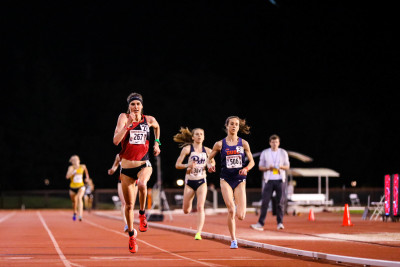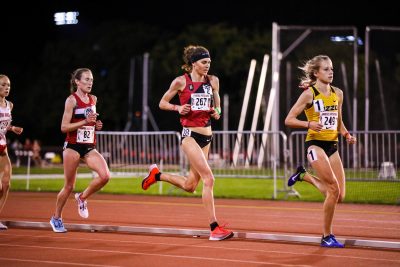5 Months In, After 31:55 10,000m Win, LetsRun.com Analyzes Gwen Jorgensen’s Olympic Marathon Dreams
by LetsRun.com
April 2, 2018
Good Monday LetsRun.com nation.
We’re pretty sure this past weekend Colleen Quigley did not get married and know for a fact that Mo Farah did not get disqualified from the 2017 Worlds 10,000m (April Fools!), but 2016 Olympic triathlon champion Gwen Jorgensen did run 31:55 to win the Stanford Invite as she continues to make her transition to running and her stated goal of winning the 2020 Olympic marathon in Tokyo.
This was Gwen’s second race as a professional runner, her first being a 15:15 5000m in February. We spent much of our regular Monday morning staff conference call debating what we thought of Gwen’s run, and decided to bring the debate online and to our forums to try to make sense of it.
 Jorgensen Wins Stanford Invite 10,000m (photo via @TALBOTCOX)
Jorgensen Wins Stanford Invite 10,000m (photo via @TALBOTCOX)
LRC Founder Weldon Johnson (Wejo): I’m not really sure where to begin. Gwen’s way ahead of where I thought she’d be at this point. She beat the NCAA champion at 3000 and 5000 in a 10,000 which is very impressive. Yet at the same time, this run on performance tables isn’t as fast as her 5,000m back in February which was only six months after she gave birth. Am I surprised she beat NCAA champ Karissa Schweizer? Yes. Am I surprised she ran 31:55? No.
Anytime you win a race you deserve some extra credit.
This runs shows she’s progressing in her training, but she’s got a long way to go to just make the Olympic team in the marathon. That’s going to be the hardest Olympic team for a long distance runner to make by far in the US. But she’s still got close to two years before the 2020 Trials take place.
Jonathan Gault: My main takeaway from our discussion during the conference call: I think Gwen Jorgensen has a better chance to make the Olympic marathon team now than I did five months ago. Her 15:15 indoors was incredibly impressive, and while 31:55 isn’t a time that will have people going crazy, Jorgensen said her main aim at Stanford was to win and she did that fairly comfortably.
Remember, last year Shalane Flanagan ran 31:38 in her first race of the year at the Portland Track Festival and won the NYC Marathon five months later. The comparison isn’t perfect — Flanagan was just returning after an extended injury break — but Jorgensen also had some things working against her (giving birth in August, switching from triathlon to running full-time).
I agree with Weldon that there’s still a long way to go, but more than anything, it makes me excited for the 2020 Olympic Trials. Or I should say, even more excited, because the Olympic Trials are always awesome. Jorgensen is a high-ceiling athlete who will add an element of uncertainty to the race, and she’s already shown an ability to get it done on the biggest stage (albeit in triathlon). I view Jorgensen’s potential as similar to that kid in high school who played soccer in the fall but then comes out and shocks the full-time runners with a big kick to win the state meet in the mile.
Robert Johnson (Rojo): At first I was going to say this: Jorgensen – who is amazing by the way in so many ways (how she is competing so well so close to childbirth blows my mind) – has already accomplished more in running than I thought she ever would. But I like to let facts, not emotions, rule the day so I went back and read what I wrote about her in November when it was announced she was going to become a full-time runner.
Back then, I noted her 10-mile PB was worth 2:28 or 2:29 in the marathon and 31:50-32:10 for 10k (and she’d run 32:12 in a road 10k before). Well guess what – she just ran 31:55 and beat a 2:30 marathoner at Stanford. So I’m not stunned by the 10k (I’m very surprised she beat Schweizer). The 5000 time, on the other hand ,really surprised me.
The big concern I have now is, “Is she better at shorter distances than longer distances, which will be a big problem in the marathon?”
I am one of the 18,000+ people to have watched her pre-race YouTube video and in it she said she was hoping to do a half marathon but coach Jerry Schumacher didn’t think she was ready for it. Plus she’s 5’10. Can you tell me how many elite 5’10 female marathoners there are? The shorter you are in the marathon, the better.
But looking at the big picture, her first few races have me more interested in following her than before and I was already into her story. This clearly isn’t some joke just to get money like Conor McGregor fighting Floyd Mayweather. Big picture, I still think her odds of Olympic gold in the marathon – which is her self-professed goal – are zero and think the goal should be to make an Olympic team as a runner.
Making the Olympics seems doable – only 9 US women broke 15:15 last year and in 2016 – but I don’t think she’ll make it as a marathoner. Even if Flanagan retires before the 2020 Trials, she’s not beating (Jorgan) Hasay, (Amy) Cragg, or (Molly) Huddle.
 Jorgensen Leads Schweizer (via @talbotcox)
Jorgensen Leads Schweizer (via @talbotcox)
Steve Soprano: I have to say that I’m very impressed by what Jorgensen has done so far as a full-time runner. Running 15:15 and 31:55 is better than I would have predicted she’d have run so soon. When she originally announced that she wanted to win Olympic gold in the marathon I gave her zero chance. I did acknowledge that she had a shot at making the Olympic team though, but said I would “be shocked and extremely impressed” if she did. Now that it’s five months later, has anything she’s done changed my mind? Well, no. I still give her zero chance to win Olympic gold and I still think she has a shot at making the USA marathon team, but it’s a longshot.
Her chances haven’t improved a ton in my eyes, because I would have never tried to argue that she wasn’t capable of running these kind of times to begin with. As Rojo said, they are in line with what she should be capable of. However, being genetically capable of something and then actually getting the fitness and executing the race to do it are two different things. Considering the fact she’s coming off childbirth, switching from the triathlon, and that she ran 15:15 in an indoor 5000 in February, I’m a little surprised. A lot could have gone wrong at this point, but it hasn’t.
So while she hasn’t done enough to make me think she can beat Hasay, Cragg, or Huddle to make the Olympic marathon team, I do think she might have a better shot at making it in the 5000 where competition at the US-level isn’t as deep. Basically, if she’s running 15:15 indoors with all she had working against her, you have to think she at least has a shot at knocking on the door of 15-flat by outdoors (certainly by outdoors in 2020). And if you’re a low-15 5000 woman, you have a chance at making the US team. Looking back at the 2016 Trials, Kim Conley made it to Rio and her PB is only 15:08, so Jorgensen already isn’t too far off. Maybe she should think about switching focus to the track or at least keep that as a backup plan if she doesn’t make it at the marathon. She isn’t going to win Olympic gold at that distance either, but she just might win a free ticket to Tokyo.
Wejo: I think we should open up this debate to the LetsRun.com message boards, and continue it there, but before we do a few final comments here from me.
- Rojo says, “Even if Flanagan retires before the 2020 Trials, she’s not beating Hasay, Cragg, or Huddle.” You state it as a fact, but someone can get hurt, have an off day, etc. Two years is a long way from now and Jorgensen has the most upside with two more years of running training. If she’s the 4th best person heading into the Trials, that is all she really could ask for.
- I think we’re nitpicking Jorgensen’s time a little too much. It’s not inconceivable all-out she could have run 31:30 this weekend. So couldn’t she be a sub-31 runner by 2020? Only 4 US women have ever run under 31 minutes. Jordan Hasay’s PB is 31:39, Amy Cragg’s 31:10. So the real question is how does she take to the marathon? Hasay, in particular, has shown that the marathon is a completely different beast than the 10,000m.
- Steve says the 5,000m might be her best shot to make an Olympic running team, and while I agree that might be the case (or the 10,000m), I don’t think she’ll try to go that route. There’s way more money in the marathon and she has no shot at a medal at those events, so her chances for being a world beater are in the marathon. Plus, I’ve heard there might be some backdoor way for her to make the Olympics in the triathlon if this doesn’t work out. Can some triathlon person on the the thread in the forums tell us how that would work?
Gwen Jorgensen Stanford 10,000m video (her post-race interview starts here)
Gwen Jorgensen Pre-Stanford Video:
